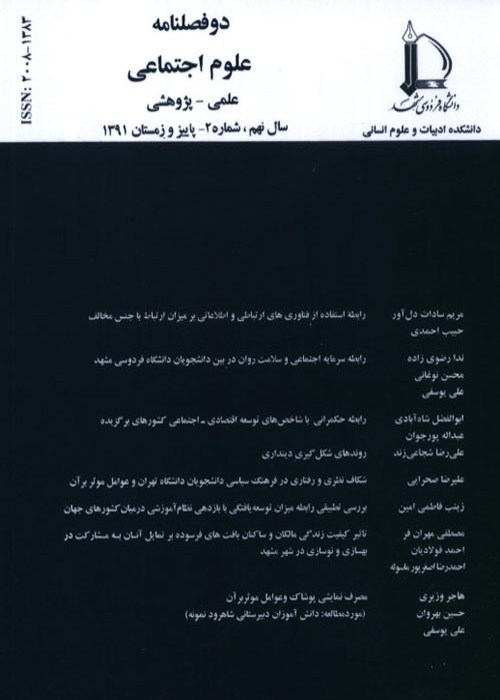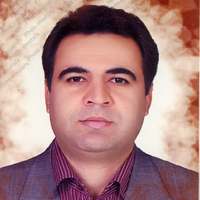Investigating the Role of Social Identity in Determining the Lifestyle of Youths in Hamedan, Iran
Author(s):
Article Type:
Research/Original Article (دارای رتبه معتبر)
Abstract:
IntroductionAsking questions about human instinct and nature and his/her relationship with others has been the very essence of human beings thoughts throughout their psychological, intellectual, and civilizational life. In other words, humans have always been passionate about their feelings of personal distinction, personal continuity, and personal independence (Tajik, 2005). On the other hand, lifestyle is also among the concepts in social sciences, which has been in the spotlight during the recent decades, especially, following the works of Pierre Bourdieu and his followers. This concept may be used to gain a better understanding of daily life conditions in large cities. Therefore, considering recent changes in the Iranian society, one could use concepts such as lifestyle and social identity to perceive certain frameworks which reveal the similarities and differences among individuals. The main question of this research is as follows: Is there a significant correlation among the dimensions of social identity? Is there a significant correlation between the dimensions of social identity and lifestyle?
Theoretical FrameworkThe theoretical basis of this research is a combination of the theories of Bourdieu, Max Weber, and Anthony Giddens. In todays world, the culture of consumption provides consumers with a wide range of choices and each choice is an indication of some values, interests, attitudes and tastes which may be peculiar to a certain social group. Hence, lifestyle is connected to social identity. The hypotheses of this study are as follows: The lifestyle of youths in Hamedan in terms of their activities varies based on their identity (i.e., religious identity, ethnic identity, family identity, and group identity).
The lifestyle of youths in terms of their interests varies based on their identity.
The lifestyle of youths in terms of their attitudes varies based on their identity.
MethodThe current research was a survey study which was conducted through a questionnaire. The sample population consisted of all the youths between 15 and 29 years of age in Hamedan, Iran. Based on the 2005 national population census, the total number of youths in Hamedan was 164152. Overall, 383 individuals were selected through Cochrans sample size formula. Sampling was done through multi-stage stratified sampling method. Accordingly, Hamedan was divided into 50 neighborhoods according to the model provided by the Statistical Centre of Iran. Then, random clusters were chosen from each neighborhood and the subjects were selected from the clusters. In order to measure the variables and collect the necessary data and information, two self-structured questionnaires were used. The items of the questionnaires were designed based on the theoretical framework, background of the study, and definitions of the variables and concepts used in the hypotheses.
After designing the items and structuring the questionnaires using the comments of several researchers and university professors, as well as adding and deleting some items, the face validity of the questionnaires were confirmed. Subsequently, factor analysis was conducted on the collected data. Hence, the construct validity of the questionnaire has also been investigated and confirmed in this study.
FindingsIt may be argued that youths have different lifestyles based on their social identity. The results also indicate that religious identity has a decisive role in the degree of religious activities and interests of youths. On the other hand, group identity has a critical impact on their degree of group and sport activities as well as the sports interests of youths in Hamedan. Group identity also influences the extent to which youths possess modern attitudes to life. The lifestyle of young individuals in terms of activities varies based on their identity (i.e., family identity, group identity, ethnic identity, and religious identity). Also, the degree of modern attitudes in group identity was significantly higher than religious, family, and ethnic identities. However, the degree of modern attitudes did not vary among family, religious, and ethnic identities.
Discussion and ConclusionsReligious identity has a decisive role in the degree of religious activities and interests of youths in Hamedan, Iran. In addition, group identity has a critical impact on their degree of group and sport activities as well as the sports interests of youths in Hamedan. Group identity also influences the extent to which youths possess modern attitudes. This finding may be explained through social pressure theories which result from group membership. Another explanation for this finding may be that the young subjects included in the sample strongly need social confirmation in order to enter the world outside their family. Therefore, it may be stated that young individuals, as social groups involved in a competition for controlling specific social fields, use the economic and cultural capitals which they have accumulated in order to reach their desirable symbolic order, so as to control the afore-mentioned fields. On the other hand, it has to be admitted that in a real-life situation, the concept of youth which refers to a distinguished social group is defined and determined by explicit (legal) and implicit (cultural) norms. Consequently, social conditions such as economic, educational, and media-related decisions may influence this procedure. Therefore, future studies in this area have to adopt a more general viewpoint to investigate and analyze the common problems related to the young population of the society.
Theoretical FrameworkThe theoretical basis of this research is a combination of the theories of Bourdieu, Max Weber, and Anthony Giddens. In todays world, the culture of consumption provides consumers with a wide range of choices and each choice is an indication of some values, interests, attitudes and tastes which may be peculiar to a certain social group. Hence, lifestyle is connected to social identity. The hypotheses of this study are as follows: The lifestyle of youths in Hamedan in terms of their activities varies based on their identity (i.e., religious identity, ethnic identity, family identity, and group identity).
The lifestyle of youths in terms of their interests varies based on their identity.
The lifestyle of youths in terms of their attitudes varies based on their identity.
MethodThe current research was a survey study which was conducted through a questionnaire. The sample population consisted of all the youths between 15 and 29 years of age in Hamedan, Iran. Based on the 2005 national population census, the total number of youths in Hamedan was 164152. Overall, 383 individuals were selected through Cochrans sample size formula. Sampling was done through multi-stage stratified sampling method. Accordingly, Hamedan was divided into 50 neighborhoods according to the model provided by the Statistical Centre of Iran. Then, random clusters were chosen from each neighborhood and the subjects were selected from the clusters. In order to measure the variables and collect the necessary data and information, two self-structured questionnaires were used. The items of the questionnaires were designed based on the theoretical framework, background of the study, and definitions of the variables and concepts used in the hypotheses.
After designing the items and structuring the questionnaires using the comments of several researchers and university professors, as well as adding and deleting some items, the face validity of the questionnaires were confirmed. Subsequently, factor analysis was conducted on the collected data. Hence, the construct validity of the questionnaire has also been investigated and confirmed in this study.
FindingsIt may be argued that youths have different lifestyles based on their social identity. The results also indicate that religious identity has a decisive role in the degree of religious activities and interests of youths. On the other hand, group identity has a critical impact on their degree of group and sport activities as well as the sports interests of youths in Hamedan. Group identity also influences the extent to which youths possess modern attitudes to life. The lifestyle of young individuals in terms of activities varies based on their identity (i.e., family identity, group identity, ethnic identity, and religious identity). Also, the degree of modern attitudes in group identity was significantly higher than religious, family, and ethnic identities. However, the degree of modern attitudes did not vary among family, religious, and ethnic identities.
Discussion and ConclusionsReligious identity has a decisive role in the degree of religious activities and interests of youths in Hamedan, Iran. In addition, group identity has a critical impact on their degree of group and sport activities as well as the sports interests of youths in Hamedan. Group identity also influences the extent to which youths possess modern attitudes. This finding may be explained through social pressure theories which result from group membership. Another explanation for this finding may be that the young subjects included in the sample strongly need social confirmation in order to enter the world outside their family. Therefore, it may be stated that young individuals, as social groups involved in a competition for controlling specific social fields, use the economic and cultural capitals which they have accumulated in order to reach their desirable symbolic order, so as to control the afore-mentioned fields. On the other hand, it has to be admitted that in a real-life situation, the concept of youth which refers to a distinguished social group is defined and determined by explicit (legal) and implicit (cultural) norms. Consequently, social conditions such as economic, educational, and media-related decisions may influence this procedure. Therefore, future studies in this area have to adopt a more general viewpoint to investigate and analyze the common problems related to the young population of the society.
Keywords:
Language:
Persian
Published:
Journal of Social Sciences, Volume:14 Issue: 1, 2017
Pages:
157 to 188
magiran.com/p1794149
دانلود و مطالعه متن این مقاله با یکی از روشهای زیر امکان پذیر است:
اشتراک شخصی
با عضویت و پرداخت آنلاین حق اشتراک یکساله به مبلغ 1,390,000ريال میتوانید 70 عنوان مطلب دانلود کنید!
اشتراک سازمانی
به کتابخانه دانشگاه یا محل کار خود پیشنهاد کنید تا اشتراک سازمانی این پایگاه را برای دسترسی نامحدود همه کاربران به متن مطالب تهیه نمایند!
توجه!
- حق عضویت دریافتی صرف حمایت از نشریات عضو و نگهداری، تکمیل و توسعه مگیران میشود.
- پرداخت حق اشتراک و دانلود مقالات اجازه بازنشر آن در سایر رسانههای چاپی و دیجیتال را به کاربر نمیدهد.
In order to view content subscription is required
Personal subscription
Subscribe magiran.com for 70 € euros via PayPal and download 70 articles during a year.
Organization subscription
Please contact us to subscribe your university or library for unlimited access!



